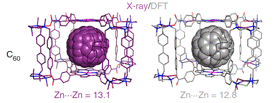Home > Press > A sponge-like molecular cage for purification of fullerenes
 |
Abstract:
A work in Nature Communications presents a supramolecular nanocage which encapsulates fullerenes of different sizes and allows the extraction of pure C60 and C70 through a washing-based strategy. The work was coordinated from the Universitat de Girona and participated by Ramón y Cajal Researcher Dr. Inhar Imaz and ICREA Research Prof. Daniel Maspoch from the ICN2 Supramolecular NanoChemistry & Materials Group..
A sponge-like molecular cage for purification of fullerenes
Barcelona, Spain | Posted on December 15th, 2014A fullerene is a molecule made of carbon that can be found in many shapes, such as spheres or tubes. They have a wide range of applications, highlighting their extensive use as electroactive materials in solar cells and with continuously appearing new uses in medicine. Any application, however, is limited in origin by tedious solid-liquid extractions (usually in toluene) and time-expensive chromatographic separations. Even the extraction of small amounts of purified fullerenes for research purposes becomes a complex process.
A work in Nature Communications recently presented a supramolecular nanocage synthesized by metal-directed self-assembly, which encapsulates fullerenes of different sizes. The study was led from the Universitat de Girona and participated by the UAB Department of Chemistry, the ALBA Synchrotron and the ICN2 Supramolecular NanoChemistry & Materials Group, from which RyC Researcher Dr. Inhar Imaz and ICREA Research Prof. Daniel Maspoch are among the authors.
The article provides direct experimental evidence for the 1:1 encapsulation of C60, C70, C76, C78 and C84, fullerene molecules consisting of 60, 70, 76, 78 and 84 carbon atoms respectively. Solid state structures for the caged fullerenes with C60 and C70 have been obtained using X-ray synchrotron radiation. With a washing-based strategy it is possible to exclusively extract pure C60 from a solid sample of cage charged with a mixture of fullerenes.
This tetragonal prismatic supramolecular cage with a high affinity for the inclusion of fullerenes, and a facile ability to release them by solvent washing of the solid inclusion compound, is an attractive methodology to selectively extract C60 and, with a lower efficiency, C70 from fullerene mixtures. Although the method cannot be used to produce big amounts of purified fullerenes, it provides an experimental platform to design tuned cages for selective extraction of higher fullerenes. The solid-phase fullerene encapsulation and liberation represent a twist in host-guest chemistry for molecular nanocage structures.
####
For more information, please click here
Contacts:
Alicia Labian
Copyright © ICN2
If you have a comment, please Contact us.Issuers of news releases, not 7th Wave, Inc. or Nanotechnology Now, are solely responsible for the accuracy of the content.
| Related Links |
| Related News Press |
News and information
![]() Researchers develop molecular qubits that communicate at telecom frequencies October 3rd, 2025
Researchers develop molecular qubits that communicate at telecom frequencies October 3rd, 2025
![]() Next-generation quantum communication October 3rd, 2025
Next-generation quantum communication October 3rd, 2025
![]() "Nanoreactor" cage uses visible light for catalytic and ultra-selective cross-cycloadditions October 3rd, 2025
"Nanoreactor" cage uses visible light for catalytic and ultra-selective cross-cycloadditions October 3rd, 2025
Nanotubes/Buckyballs/Fullerenes/Nanorods/Nanostrings
![]() Enhancing power factor of p- and n-type single-walled carbon nanotubes April 25th, 2025
Enhancing power factor of p- and n-type single-walled carbon nanotubes April 25th, 2025
![]() Chainmail-like material could be the future of armor: First 2D mechanically interlocked polymer exhibits exceptional flexibility and strength January 17th, 2025
Chainmail-like material could be the future of armor: First 2D mechanically interlocked polymer exhibits exceptional flexibility and strength January 17th, 2025
![]() Innovative biomimetic superhydrophobic coating combines repair and buffering properties for superior anti-erosion December 13th, 2024
Innovative biomimetic superhydrophobic coating combines repair and buffering properties for superior anti-erosion December 13th, 2024
Discoveries
![]() Researchers develop molecular qubits that communicate at telecom frequencies October 3rd, 2025
Researchers develop molecular qubits that communicate at telecom frequencies October 3rd, 2025
![]() Next-generation quantum communication October 3rd, 2025
Next-generation quantum communication October 3rd, 2025
![]() "Nanoreactor" cage uses visible light for catalytic and ultra-selective cross-cycloadditions October 3rd, 2025
"Nanoreactor" cage uses visible light for catalytic and ultra-selective cross-cycloadditions October 3rd, 2025
Announcements
![]() Rice membrane extracts lithium from brines with greater speed, less waste October 3rd, 2025
Rice membrane extracts lithium from brines with greater speed, less waste October 3rd, 2025
![]() Researchers develop molecular qubits that communicate at telecom frequencies October 3rd, 2025
Researchers develop molecular qubits that communicate at telecom frequencies October 3rd, 2025
![]() Next-generation quantum communication October 3rd, 2025
Next-generation quantum communication October 3rd, 2025
![]() "Nanoreactor" cage uses visible light for catalytic and ultra-selective cross-cycloadditions October 3rd, 2025
"Nanoreactor" cage uses visible light for catalytic and ultra-selective cross-cycloadditions October 3rd, 2025
Interviews/Book Reviews/Essays/Reports/Podcasts/Journals/White papers/Posters
![]() Spinel-type sulfide semiconductors to operate the next-generation LEDs and solar cells For solar-cell absorbers and green-LED source October 3rd, 2025
Spinel-type sulfide semiconductors to operate the next-generation LEDs and solar cells For solar-cell absorbers and green-LED source October 3rd, 2025
![]() Rice membrane extracts lithium from brines with greater speed, less waste October 3rd, 2025
Rice membrane extracts lithium from brines with greater speed, less waste October 3rd, 2025
|
|
||
|
|
||
| The latest news from around the world, FREE | ||
|
|
||
|
|
||
| Premium Products | ||
|
|
||
|
Only the news you want to read!
Learn More |
||
|
|
||
|
Full-service, expert consulting
Learn More |
||
|
|
||








